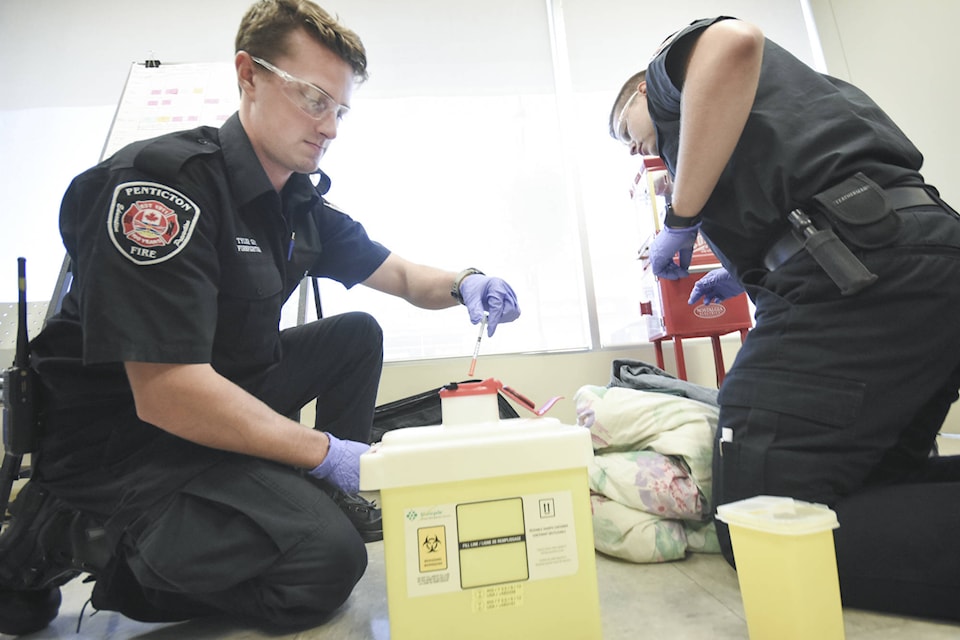Does Penticton need an overdose prevention site?
That’s the question an ad hoc committee of interested groups is looking at answering, as an overdose crisis continues to throttle B.C., according to South Okanagan Women In Need Society executive director Debbie Scarborough.
The B.C. government website says supervised injection sites, also called supervised consumption sites, are available in Kelowna and Kamloops alone in the Interior Health region, with no mention of overdose prevention sites (OPS) in the region.
Related: Nine suspected fatal overdoses over five days in IH region
Just a subtle change differentiates between an overdose prevention site and a supervised consumption site. An OPS only monitors those who have used drugs in case of an overdose, and may provide some services, such as clean needles and naloxone afterwards, whereas a supervised consumption site oversees the consumption of substances.
Though appearing minor in their differences, an OPS does not need to hop the same major red-tape hurdles with the federal government as a supervised consumption site, while still providing low-barrier access to harm reduction supplies and services.
“We are looking at that, yes,” Scarborough said. “Definitely within the last year we’ve been working very diligently on that.”
Details on the potential for an OPS remain scarce, with no decision made on whether the city will get one, but Interior Health mental health and substance use manager Kevin Fraser confirmed in a brief statement that the health authority is looking at the option.
Related: Penticton hospital fourth busiest in the region for opioid overdose
“Interior Health is working closely with community partners in Penticton to determine the feasibility of an overdose prevention site,” Fraser said. “We are in the very early stages of these discussions, and no decisions have been made at this time. We will share information publicly as these plans progress.”
What is closer to fruition, however, is a sharps disposal program that would set up bins for needles and other sharp objects at substance use hotspots in town.
Scarborough said injection drug users will typically walk about 300 metres to dispose of a needle properly, and the presence of bins would dramatically reduce the number of sharps found around the city — something Penticton Fire Chief Larry Watkinson said the fire department has had an increase in calls for.
Related: More needles found in downtown Penticton
“We’ve always done needle pickups, it’s just become more predominant in the last year, pretty well, year and a bit, since the fentanyl crisis,” Watkinson said.
“We come when we’re available or when we’re even out of quarters, we’ll stop by, but it’s important, but we’re not going to take ourselves out of service to do that.”
Last Wednesday, the fire department had three calls for needle pickups in one day, though Watkinson said the issue was likely because of snow melting and needles in the snow becoming more apparent all at once.
“We kind of anticipated that, actually, that once the snow banks kind of deteriorate and the snow plows have done their work and now we have debris piles and needles are in them,” he said.
The City of Penticton, Watkinson with the fire department, the South Okanagan Similkameen Brain Injury Society and 100 Homes Penticton are all taking part in the sharps committee, which Scarborough said has made some headway. SOWINS mobile outreach and SAFExst co-ordinator Gwen Wain recently consulted with drug users to find some spots around the city to put the bins.
Related: Interior Health issues illicit drug alert after spike of overdoses in B.C.
“The city provided a map to Gwen, and Gwen worked with those clients and they’ve identified the hotspots where there could be some sharps containers, and then there will be a schedule on who would empty them, and then have them safely disposed, probably through Interior Health,” Scarborough said.
One of the issues with some of the bathroom sharps containers has been overflowing, which Scarborough said would be resolved through participants in the program checking in on sharps bins and letting those in charge of pickup know where the bins are at.
Scarborough wouldn’t say how many hotspots have been identified or pointed out, reluctant to potentially concern neighbouring properties before the details and consultations are worked out, but said she doesn’t expect too much pushback.
“These are not the places that the people would normally frequent that aren’t using,” she said.
“I think it’s the reality, and if we want people to dispose of their needles, we need to provide a place. The proof is that the majority of people, if they’re there, will dispose of their needles the right way.”
